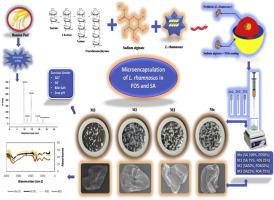Food Bioscience ( IF 4.8 ) Pub Date : 2020-06-29 , DOI: 10.1016/j.fbio.2020.100679 Muhammad Azam , Muhammad Saeed , Imran Pasha , Muhammad Shahid

|
Fructooligosaccharides (FOS) improve viability of probiotics and gastrointestinal health. FOS and alginate as encapsulation material, can provide better structure of beads to improve the survival of probiotics. The present study focused on FOS extraction from banana peel to encapsulate L. rhamnosus and explore its in vitro survival through structural interactive optimization of encapsulation materials. FOS and sodium alginate (SA) were used for encapsulation of L. rhamnosus with different formulations, e.g., Mo (100% SA), M1 (75% SA + 25% FOS), M2 (50% SA + 50% FOS), M3 (25% SA + 75% FOS) and M4 (FOS 100%). The stability of free and encapsulated L. rhamnosus was assessed using gastrointestinal conditions. All the treatments provided better encapsulation efficiency except M4. Microencapsulation significantly maintained viability of L. rhamnosus using simulated gastric conditions, bile salt, low pH and during storage. M2 was considered as the best encapsulation treatment for survival of L. rhamnosus. The SA beads have pores but addition of FOS improved the structure of the beads. Fourier transform infrared spectrometry results showed the presence of FOS and SA in the respective treatments. Principal component analysis (PCA) explained differences among bead formulations using spectral data. In simulated gastric juice, maximum viability was observed (8.5 ± 0.1 log CFU/mL) due to increased concentration of FOS. The FOS were extracted from banana peel and successfully used as a prebiotic encapsulation material for effective delivery of L. rhamnosus. The different combinations of wall materials provided an opportunity to develop beads with better structure and protection.
中文翻译:

基于益生元的生物聚合物封装系统,可提高鼠李糖乳杆菌的存活率
低聚果糖(FOS)可提高益生菌的生存能力和胃肠道健康。FOS和藻酸盐作为包封材料,可以提供更好的微珠结构,从而提高益生菌的存活率。本研究的重点是从香蕉皮中提取FOS以包囊鼠李糖乳杆菌,并通过包囊材料的结构相互作用优化探索其体外存活。FOS和藻酸钠(SA)用于以不同的配方封装鼠李糖乳杆菌,例如M o(100%SA),M 1(75%SA + 25%FOS),M 2(50%SA + 50% FOS),M 3(25%SA + 75%FOS)和M 4(FOS 100%)。使用胃肠道条件评估游离的和包囊的鼠李糖乳杆菌的稳定性。除M 4外,所有处理均提供了更好的包封效率。在模拟的胃部条件,胆汁盐,低pH和储存期间,微囊包封可显着保持鼠李糖乳杆菌的生存能力。M 2被认为是鼠李糖乳杆菌存活的最佳封装方法。SA珠具有孔,但是添加FOS改善了珠的结构。傅立叶变换红外光谱法的结果表明在相应的处理中存在FOS和SA。主成分分析(PCA)使用光谱数据解释了磁珠配方之间的差异。在模拟胃液中,由于FOS浓度的增加,观察到了最大的生存能力(8.5±0.1 log CFU / mL)。FOS是从香蕉皮中提取的,并成功地用作有效递送鼠李糖乳杆菌的益生元封装材料。墙壁材料的不同组合为开发具有更好结构和防护性能的珠粒提供了机会。











































 京公网安备 11010802027423号
京公网安备 11010802027423号